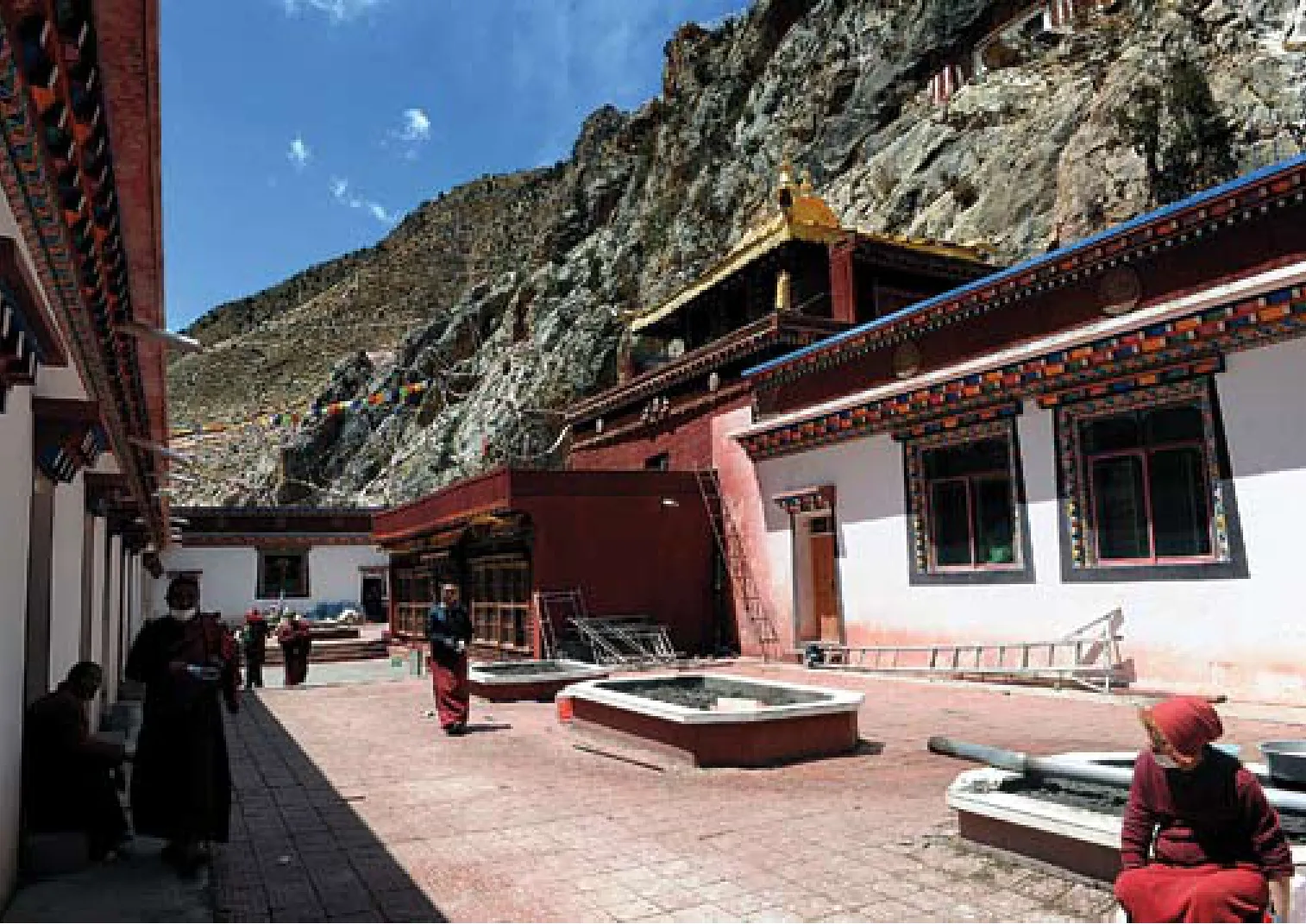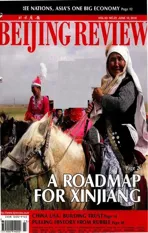Rescuing Yushu’s Culture
2010-10-14ByYINPUMIN
By YIN PUMIN
Rescuing Yushu’s Culture
By YIN PUMIN
The cultural relics seriously damaged by a devastating earthquake in April 2010 are being restored
Besides leaving at least 2,600 people dead and more than 100,000 homeless, the 7.1-magnitude earthquake, which jolted the Yushu Tibetan Autonomous Prefecture in northwest China’s Qinghai Province on April 14, 2010,seriously damaged large numbers of the area’s cultural relics.
Five national-level and 23 provinciallevel cultural relic sites in Qinghai and neighboring Sichuan Province were shattered during the quake, said Guan Qiang, Deputy Director of the Department of Cultural Heritage Conservation and Archaeology of the State Administration of Cultural Heritage(SACH), in Beijing on May 27, 2010.
The SACH investigated an area of 300,000 square km, which covers seven counties rocked by the quake in the two provinces, the administration said.
Most of the damaged cultural relics were Tibetan Buddhist monasteries and other religious places like the Gyana Mani Stone Mound in Sengza Village near Gyegu Town of the prefecture, the epicenter of the quake.
“This means we must take religious and ethnic elements into consideration when carrying out restoration work,” Guan said.
Severely damaged
The Yushu Tibetan Autonomous Prefecture boasts beautiful scenery, legends,and rich Tibetan culture. As the source of China’s three major rivers—the Yellow River, the Yangtze River and the Lancang River, the prefecture contains the world’s largest mani stone mound, a Kham culture museum and many Tibetan Buddhist monasteries and stupas.
“Most of the prefecture’s monasteries collapsed, including the 700-year-old Thrangu Monastery and the 2,000-year-old Gyegu Monastery,” said Guo Hong, Deputy Director of the Qinghai Provincial Bureau of Cultural Heritage.
The Thrangu Monastery is the biggest monastery of the Kagyu Sect of Tibetan Buddhism in Yushu Tibetan Autonomous Prefecture and has a huge collection of Buddhist scriptures. During the quake,Thrangu was the hardest hit of all monasteries in the prefecture.
China National Radio reported 31 of 260 monks at the monastery died and another 27 were injured.
The main hall came to the verge of collapse because of cracked walls, while surrounding buildings, including the bedrooms of the monks, two meditation centers and at least three other halls were reduced to rubble,said the report.
Many cultural relics including Buddist scriptures, statues, tangka and Tibetan scroll paintings, were buried under the rubble. A tangka is a form of traditional Tibetan painting or embroidery on silk, paper or other materials, usually depicting a Buddhist deity,famous scene or mandala.
The Gyegu Monastery, the largest Tibetan Buddhist monastery in the prefecture,was ruined.
“The scripture hall, with a history of more than 500 years, was totally destroyed, and eight of 500 monks there lost their lives,” said a 35-year-old monk who is responsible for managing the hall in an article ofGuangzhou Daily.
Besides the scripture hall, the main body of the institute of Buddhism learning collapsed and the stupas were completely ruined.
The Gyana Mani Stone Mound in the prefecture’s Yushu County, a holy place to local Tibetans and the largest of its kind in the world, was reduced to a chaotic tangle of rubble by the quake .
The site consists of a mani stone mound,two prayer halls, 490 prayer wheels and 14 pagodas. Three pagodas collapsed and cracks were visible in others.
The 1,300-year-old Temple of Princess Wencheng in Yushu County was not greatly affected in the quake, but the stone cliff behind its main hall has begun to crack,threatening the structure.
Rescue in action
Immediately following the quake, the SACH and the Provincial Government of Qinghai launched a project to rescue the damaged cultural relics.

TAKING CARE:Soldiers of the Chinese People’s Armed Police Force dig out a Buddhist statue from rubble at the Thrangu Monastery in Yushu Tibetan Autonomous Prefecture in northwest China’s Qinghai Province on April 19, 2010


(Left)STANDING STILL:Monks at the Temple of Princess Wencheng carry on with life. The temple was not greatly damaged in the earthquake on April 14, 2010
The SACH set up an expert team four days after the quake to investigate and secure the damaged sites. Local governments took tight security measures and set up temporary protection facilities around the damaged sites.
Fortunately, the Tibetan version ofTripitaka, a Buddhist canon of scriptures,was rescued undamaged from the rubble.The rescued TibetanTripitaka, having been protected by a Tibetan family for more than 1,000 years, is the oldest and most complete TibetanTripitakafound today. It is now under special protection of the local government.
On April 20, 2010, after more than four hours of excavation, a team of soldiers from the Chinese People’s Armed Police Force(CPAPF) rescued a piece of a 600-yearold tangka from the debris of the Thrangu Monastery.
Huang Zhiyuan, an of fi cer of the CPAPF,told thePLA Dailythat the soldiers recovered more than 2,000 valuable cultural relics from the damaged monastery in the six days after the quake.
Because of the delicate nature of the Buddha statues, sutra texts and tangka, the soldiers used only their hands to search for them in the debris, Huang said.
When the soldiers unearthed a Buddha statue, they used two hands to hold it and never touched the head of the statue. They dug only in the area where monks told them to, and the digging was done when monks were present.
“Every item was registered by both the temple where it was excavated and the rescue team to avoid confusion,” said Huang. “We should respect the Tibetan religion and its customs, which holds tremendous respect for these relics. In fact, we were all required to wear gloves.”
By April 23, 2010, a total of 1,635 Buddhist statues, 4,376 volumes of sutra texts and 120 pieces of tangka had been saved from the rubble.
After the fi rst stage of rescue, a team of 13 experts led by Shan Jixiang, Director of the SACH, arrived at the quake zone on April 27,2010, to help with assessment and restoration work.
On May 14, 2010, the SACH and the Qinghai Provincial Government jointly launched a rescue project, the start of the fullscale attempt of China to save cultural relics in the quake-hit area.

PRECIOUS:The Tibetan version of Tripitaka,a Buddhist canon of scriptures,was completely saved from the rubble of the earthquake on April 14, 2010
One week later, a plan worked out by the SACH for rescuing, protecting and renovating cultural relics in the earthquake-hit region was approved by experts. The three-year plan covers seven counties and 27 townships in Qinghai and Sichuan provinces hit by the earthquake.
The plan puts the Gyana Mani Stone Mound at the top of the government’s priorities for cultural relic restoration.
The repair and restoration of cultural relics in the Yushu Tibetan Autonomous Prefecture would follow the experience of similar restoration after the Wenchuan earthquake of May 12, 2008, and invite local residents to participate in restoration work,said Shan.
“Local people are welcome to help in repairing and reconstructing temples and the traditional ethnic buildings,” Shan said. “It is a good way to hand down traditional crafts and construction skills.”
Local people would also earn money from restoration work, he said.
Actually, in April 2010, a team of 14 experts led by SACH of fi cials have already been working on a reconstruction plan for the Gyana Mani Stone Mound, which covers nearly 21,000 square meters.
Hou Weidong, the chief engineer of the Chinese Academy of Cultural Heritage and head of the 14-person team, said they aimed to restoring everything to what it was before the quake.
For centuries, the sacred mound has been part of daily life in Sengze Village of Yushu County. Tibetans consider rocks from the mountains of the Qinghai-Tibet Plateau sacred and stones with sutra scripts even more so.
Before the quake, local Tibetans visited the site every day. They earned a living by engraving and selling the stones.
“The locals cannot live without the mound, so we’ll work closely with them to make sure they like every detail of the restoration plan,” Hou said.
For example, experts learned they couldn’t use a backhoe to reconstruct the mani stone heaps because of the religious belief of local people, Hou said. “We decided to do it by hand.”
At the same time, modern technologies including techniques to resist earthquakes,water and insects will also be employed in the restoration, Shan said.
Up to now, the SACH has allocated 800,000 yuan ($117,000) for the fi rst stage of rescue work. The Chinese Ministry of Culture has also allocated 3 million yuan ($439,000)for the protection of ethnic culture in the quake-hit area.
King Gesar
the great epicThe Life of King Gesar, the longest epic poem in the world, was created in the Yushu tibetan Autonomous Prefecture where, it is said, King Gesar founded his kingdom. today, a 22-meter-high statue of King Gesar, the largest of the legendary hero in the country, still stands in the Gesar Square in Gyegu town in the prefecture.
Created more than 1,000 years ago, the epic tells the story of King Gesar who conquered the devils of other tibetan tribes and made tibet a stable, peaceful and happy place to live in. Comprising 120 volumes with more than 20 million words,The Life of King Gesarhas been spread orally through generations of tibetans.
Covering the history, thinking and life of ancient tibetan society, the epic touches upon many fields including religion, myths, wars, folk customs, literature and nature. In September 2009, the epic was added by the UN Educational, Scientific and Cultural Organization to the list of the world’s intangible cultural heritage.
(Source:Mzb.com.cn, World News Journal)
